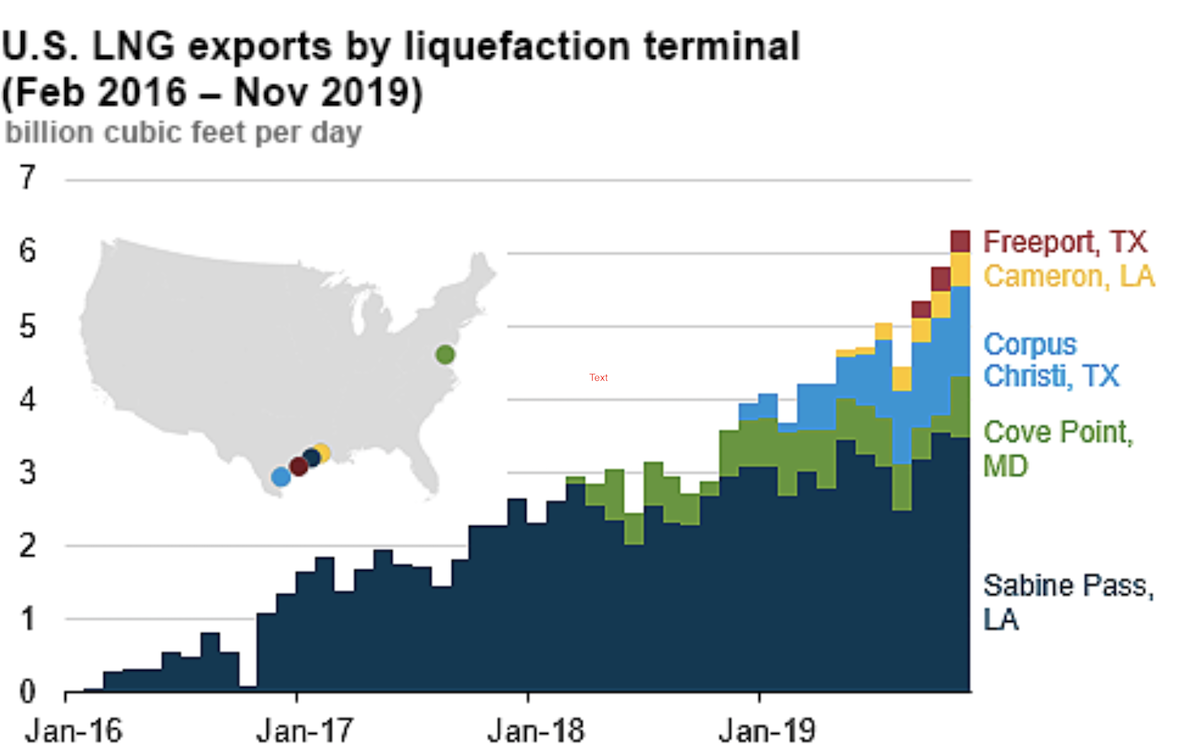Vessel Loadings Show Record U.S. LNG Exports in Oct-Nov
(P&GJ) — U.S. exports of LNG set two consecutive records in October and November 2019, according to U.S. Energy Information Administration estimates. LNG exports averaged 5.8 Bcf/d with 52 exported cargoes in October and 6.3 Bcf/d with 55 exported cargoes in November, EIA reported, citing Bloomberg Finance shipping data.
From January through November 2019, U.S. LNG exports averaged 4.8 Bcf/d – 61% higher than in 2018's 3 Bcf/d annual average – as the United States became the third-largest LNG exporter in the world as additional liquefaction capacity came online.
Two new facilities—Cameron LNG and Freeport LNG—placed their first liquefaction units in service this year, in May and September, respectively (see chart). Corpus Christi LNG commissioned its second train in July. Elba Island started LNG production from the first five of its Moveable Modular Liquefaction System (MMLS) units and is currently loading first export cargo. EIA estimates U.S. LNG nominal liquefaction capacity in operation to be 6.1 Bcf/d baseload (7.5 Bcf/d peak) across six facilities and 15 trains (10 standard-size liquefaction trains and 5 small modular liquefaction units).
Natural gas feedstock deliveries to U.S. LNG export facilities have been the fastest growing consumption sector for U.S. natural gas in 2019, increasing by 2.8 Bcf/d between January and November, based on pipeline flow data provided by IHS Markit.
Feedstock deliveries exceeded 6 Bcf/d for the first time in July, averaged 7.4 Bcf/d in November, and exceeded 8.3 Bcf/d in the second week of December as Freeport LNG started LNG production from its second train. EIA expects feedstock deliveries to continue to increase as the remaining trains at Freeport, Cameron, and Elba Island are placed in service in 2020, followed by the third train at Corpus Christi in 2021.
From January through November 2019, EIA estimates that capacity utilization of U.S. liquefaction facilities averaged 93% baseload, or 81% peak. Sabine Pass and Corpus Christi had the highest utilization of production capacity among U.S. LNG export facilities, at 105% and 91% baseload capacity, respectively, over the 11-month period.
Cheniere Energy, the operator of Sabine Pass and Corpus Christi LNG terminals, filed applications with the Federal Energy Regulatory Commission (FERC) requesting authorization to increase operational capacity of Sabine Pass and Corpus Christi based on technical upgrades that have optimized the operational performance of the facilities.
Cameron LNG ramped up baseload production capacity to 77% in November, and Freeport LNG, since commissioning Train 1 in September, ramped up production to 50% in October and November. Because commissioning new liquefaction trains is done gradually over time, utilization of the facilities in the first several months of operations typically remains below 50%.
Related News
Related News

- Trump Aims to Revive 1,200-Mile Keystone XL Pipeline Despite Major Challenges
- ONEOK Agrees to Sell Interstate Gas Pipelines to DT Midstream for $1.2 Billion
- Energy Transfer Reaches FID on $2.7 Billion, 2.2 Bcf/d Permian Pipeline
- Boardwalk Approves 110-Mile, 1.16 Bcf/d Mississippi Kosci Junction Pipeline Project
- Kinder Morgan Approves $1.4 Billion Mississippi Crossing Project to Boost Southeast Gas Supply
- Tullow Oil on Track to Deliver $600 Million Free Cash Flow Over Next 2 Years
- GOP Lawmakers Slam New York for Blocking $500 Million Pipeline Project
- Energy Transfer Reaches FID on $2.7 Billion, 2.2 Bcf/d Permian Pipeline
- Enbridge Should Rethink Old, Troubled Line 5 Pipeline, IEEFA Says
- Polish Pipeline Operator Offers Firm Capacity to Transport Gas to Ukraine in 2025





Comments